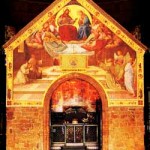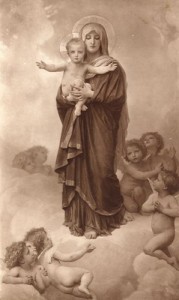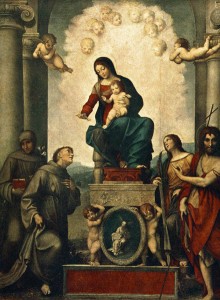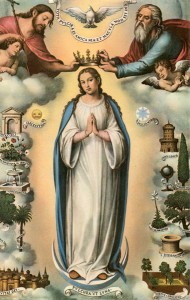 The close connection between the Blessed Virgin Mary and the Holy Angels is one we see throughout her life on Earth: at the Annunciation, the Nativity of her Divine Son, her Assumption into heaven, and finally her Coronation as Queen of Angels and Men. The first invocation of her as Queen in the Litany of Loreto is as “Queen of Angels.” This close identification of Heaven’s Queen and her angelic subjects has a deep meaning for those of us here in the Archdiocese of Los Angeles; but it has also been the cause of a bit of historical confusion.
The close connection between the Blessed Virgin Mary and the Holy Angels is one we see throughout her life on Earth: at the Annunciation, the Nativity of her Divine Son, her Assumption into heaven, and finally her Coronation as Queen of Angels and Men. The first invocation of her as Queen in the Litany of Loreto is as “Queen of Angels.” This close identification of Heaven’s Queen and her angelic subjects has a deep meaning for those of us here in the Archdiocese of Los Angeles; but it has also been the cause of a bit of historical confusion.
For starters, although the Cathedral is dedicated to “Our Lady of the Angels,” she is not, under this title, patroness of the Archdiocese — that honor goes to St. Vibiana, a Roman martyr, whose relics are enshrined in the cathedral’s crypt (although as “Refuge of Sinners” she was the patroness of the old diocese of Both Californias, from which our current archdiocese descends).. She is the patroness of the City of Los Angeles; but even though the first parish, founded under the King of Spain, is dedicated to her as Queen of Angels (and though there was a famous Catholic Hospital here named after that title), her Queenship is not mentioned in the City’s original name, nor is the feast honoring it the City’s patronal feast. Confusing? Yes, indeed. But beneath the confusion is an inspiring tale of wonder.
The first Spanish explorers named the Los Angeles River Rio Porciuncula, after the small chapel restored by St. Francis. In 1781, the little town founded on its banks was dubbed El Pueblo de Nuestra Senora de Los Angeles de Porciuncula — “The Town of Our Lady of the Angels of Porciuncula.” Although lacking the Royal title later given the parish church, it was a name deeply bound up not only with the history of the Franciscan order, but reflecting some of the most extraordinary mysteries of the Catholic Faith.
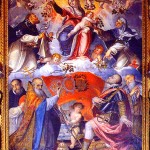
COSSALI, Grazio, Pope Pius V Credits Our Lady of the Rosary with the Victory at the Battle of Lepanto
To begin with, although the Porciuncula in Assisi is best known to us for its association with St. Francis, it had a remarkable history long before the “Poor Man of Assisi” was born. It is first mentioned in the year 1045, when it was called the Chapel of Our Lady of the Angels; the locals had heard Angels singing there, and immediately thought of the Assumption. It was in time given to a Benedictine Monastery, whose Abbot gave it to St. Francis to repair, in accordance with a dream the Saint had had. It was inside the little building that St. Francis had the vision of Christ wherein was revealed the Porciuncula Indulgence — the annual practice whereby the Faithful may gain a plenary indulgence under the usual conditions by visiting a church on August 2, the feast of Our Lady of the Angels. Originally restricted to visiting the Porciuncula itself on that day, successive Popes gradually extended the privilege to all Franciscan churches, to all parish churches, and finally to any church whatsoever. Today the Porciuncula is tucked away inside the much larger and splendid Basilica of Santa Maria degli Angeli, built around the little chapel by order of St. Pius V — himself no stranger to miracles.
Indeed, many churches under this dedication have been accompanied by wonders and marvels. In Rome itself, the Basilica of Santa Maria degli Angeli e dei Martiri (…”of the Angels and Martyrs”) is best known as the Church of the Italian Royal Family and of the State as well, where various important religious ceremonies are performed. But its origins lie in the determination of the 16th century Sicilian Priest, Antonio Lo Duca. Fr. Lo Duca received several visions of angels, and conceived of the notion of building a church in honor of the Seven Archangels amid the ruins of the Baths of Diocletian. Despite the favor of the Emperor Charles V, his attempts to interest a succession of Popes in the project failed — until Pius IV commissioned Michelangelo to design the new building.
A century later, near the town of Lurs, in Provence, villagers reported hearing angelic choirs as well as an apparition of the Virgin. The shrine was approved by the diocese for pilgrimages, and miraculous cures began. Despite the upheaval of the French Revolution, these have continued until the present.
Thirty five years earlier, in 1625, a poor woman of Cartago, in Costa Rica, discovered a small statue of the Virgin sitting on a rock in the midst of the thicket where she usually gathered firewood: it was August 2, the feast of St. Mary of the Angels. Impressed by her find, she took the image home and put it in a box. Going back for more wood at Noon, she found to her amazement an identical statue on the rock. She rushed home, only to find that the box was empty; she locked up the image once more. A third visit found the image returned to the rock, and the box at home just as empty. Frightened, she brought the image to the parish priest, who locked it up in the rectory, saying he would examine it more closely when he had the time. All to no avail! The image was back on the rock when the woman returned. This time she summoned the priest and various neighbors — forming an impromptu procession, they brought the statue back to the parish church, whereon the priest locked the statue up in the tabernacle on the altar. Yet it returned, at which priest and people realized that the Virgin wanted to stay there. The townsfolk built a chapel on the spot. In time, successively larger ones would be erected, until at last the current one, the national Marian shrine of Costa Rica, stands guard over the little statue. Here in Los Angeles, the local Costa Rican community honors Nuestra Senora de los Angeles with a procession.
These are a few stories of many shrines the world over; what a long tale of wonders Our Lady of the Angels brings in her wake! This devotion unites our city with scores of others across the globe, something which should make every Angeleno proud.
But what of the Queenship of Mary that is often inaccurately inserted into the original title of the city? As Archdiocesan Archivist Msgr. Francis J. Weber explains in his Encyclopedia of California’s Catholic Heritage (p. 1072), many of the first settlers were especially devoted to the Queenship of Mary; the Protestant 19th century historians who misquoted the original name of the City as El Pueblo de Nuestra Senora Reina de los Angeles de Porciuncula were completely unfamiliar with either the little chapel in Assisi or the long standing devotion to Our Lady of the Angels. This misnaming was in turn picked up by so many reference works and text books that it took on a life of its own.
But in any case, all of this is not merely obscure historical knowledge to be safely filed away. Not only is the Queenship of Mary and her Empire over the Americas a glittering reality; devotion to her relationship with the angels retains its relevance. In 2009, Benedict XVI promulgated the Apostolic Constitution Anglicanorum coetibus, which provides for the reception of Catholic-minded Anglicans into the Catholic Church as groups rather than as individual converts. One of the first congregations to benefit from this in our area will, in all likelihood, be the small but beautiful Anglican Church in Hollywood called St. Mary of the Angels. It is fitting that one of Our Lady’s oldest titles should be present at the beginning of one of the Church’s latest and most exciting developments. Then again, she is always present, after all.
Links
- Porciuncula
http://en.wikipedia.org/wiki/Porziuncola
http://www.porziuncola.org/home/index.php?l=it - Basilica di Santa Maria degli Angeli e dei Martiri
http://www.santamariadegliangeliroma.it/ - Notre Dame des Anges, Lurs
http://en.wikipedia.org/wiki/Chapel_of_Notre_Dame_des_Anges
http://chapelles.provence.free.fr/lursnddesanges.html - Santuario Nacional de Nuestra Senora de los Angeles
http://www.santuarionacional.org/web/ - St. Mary of the Angels, Hollywood
http://www.stmaryoftheangels.org/
